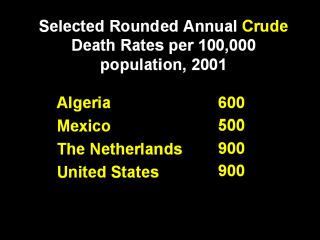 |
Comparison of
these national crude death rates reveals differences that are not intuitive.
Assuming that the rates are accurate, and actually this is a solid
assumption, then how is it that the rates displayed are higher in the two
more developed countries, the United States and The Netherlands, than in the
two less developed countries, Algeria and Mexico?
The answer to the question posed by the preceding paradox lies in
differences in the age distributions of the various populations Ė age is a
confounding variable. The less developed countries have much younger
populations than the more developed countries, as a result of having much
higher fertility rates. In our contemporary world younger people, especially
those who arenít infants, are much less likely to die than older people. We
take this as a given, but this was not always the case as John Grauntís life
table data attest. |
